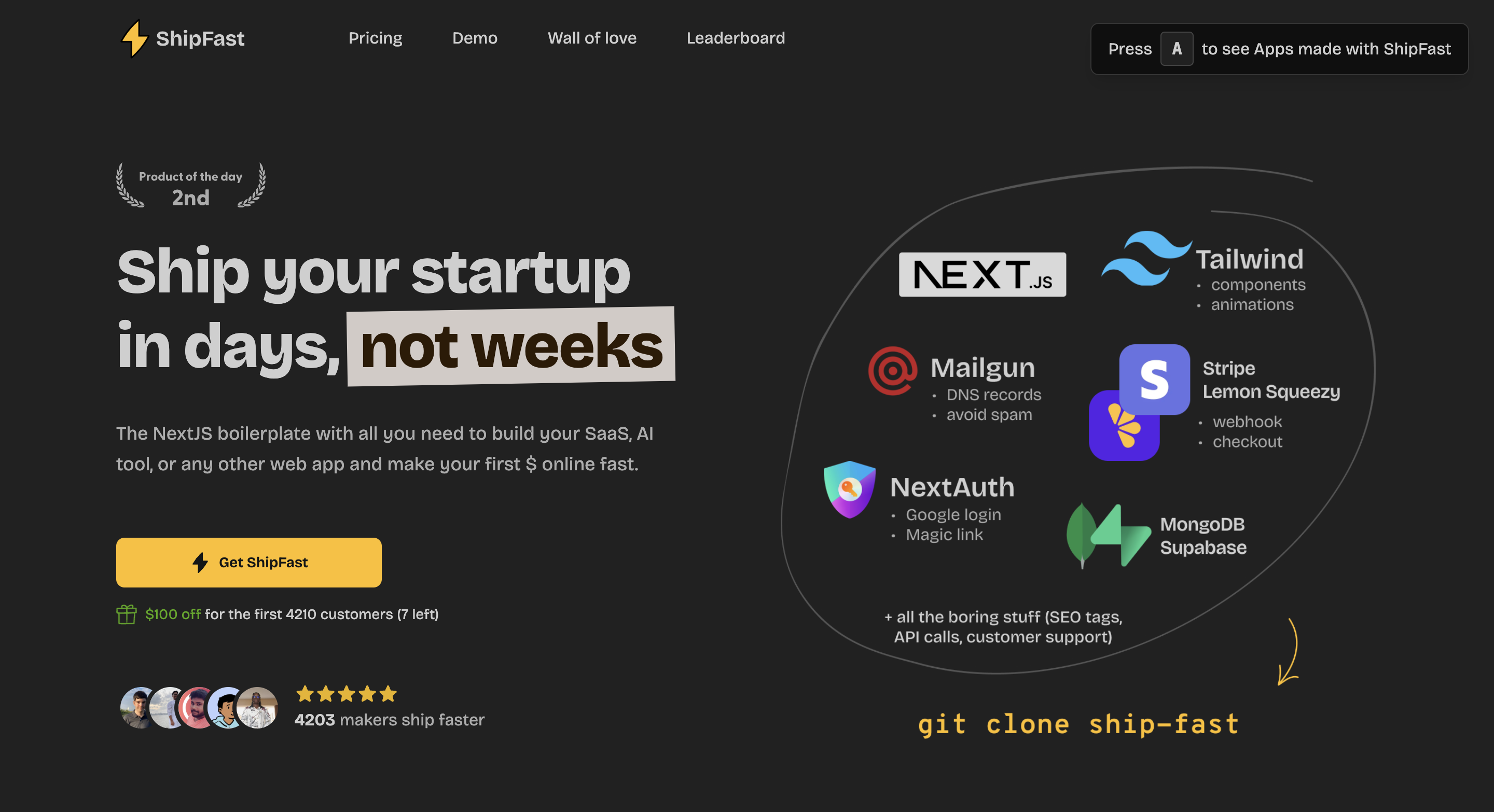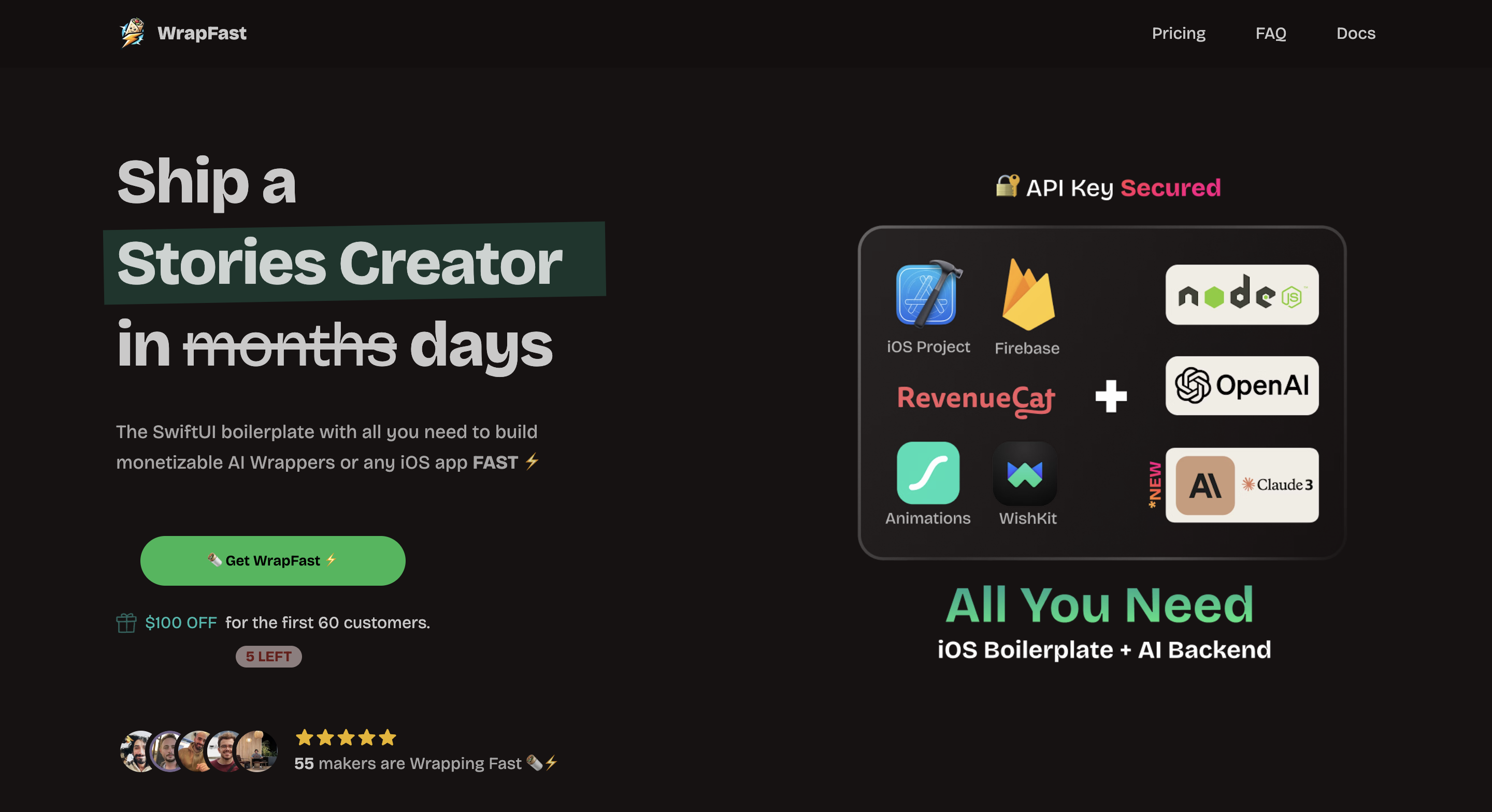development
saas
boilerplates
Best SaaS Boilerplates to Build Your App in 2025
What Are SaaS Boilerplates?
A SaaS boilerplate is a pre-built template for creating Software-as-a-Service applications. It includes basic structures, common features, and best practices to help developers start quickly. Advanced boilerplates often include ready-to-use demo apps you can immediately deploy!
Key Benefits of Using a Boilerplate
- Time Savings: Skip repetitive setup work and focus immediately on your app's unique features
- Consistency: Maintain uniform architecture and design patterns throughout your application
- Scalability: Start with a foundation that's already designed to handle growth
- Best Practices: Benefit from industry standards built into the boilerplate's core
Must-Have Features in Modern SaaS Boilerplates
Essential Infrastructure
- Authentication System: Secure, ready-to-use login flows (email, social, passwordless)
- Database Integration: Structured data storage with proper relations
- Responsive UI: Mobile-friendly design with consistent components
- API Architecture: Well-organized endpoints for client-server communication
- User Management: Account creation, roles, permissions, and profile handling
Monetization Features
- Subscription Management: Recurring billing with different pricing tiers
- Payment Gateway Integration: Support for popular payment processors
- Trial Management: Free/paid trial implementation with conversion flows
Third-Party Integrations
- AI Capabilities: Connections to language, vision, and audio AI services
- Email Services: Transactional emails and marketing communications
- Analytics Tools: User behavior tracking and performance monitoring
- Storage Solutions: File and media management options
Top SaaS Boilerplates for 2025
AnotherWrapper: The AI Development Powerhouse
AnotherWrapper isn't just a boilerplate—it's a complete AI development toolkit with 10 ready-to-use AI apps that can be deployed in minutes!

Core Features
- Full-stack Next.js implementation with modern architecture
- 10 production-ready AI applications covering various AI capabilities
- Multi-provider AI integration (OpenAI, Anthropic, Groq, Replicate)
- Complete authentication system via Supabase
- Beautiful UI with 40+ customizable themes
- Subscription management through LemonSqueezy
- Built-in analytics with PostHog
- File storage via Cloudflare R2
What Sets AnotherWrapper Apart?
AnotherWrapper's standout feature is its collection of 10 fully-functional AI demo applications:
- Text Generation (GPT): Marketing ideas generator with structured inputs
- Logo Creation (DALL·E): Logo design tool with style customization
- Image Analysis (Vision): Image interpretation and description using GPT-4o
- Advanced Chat: Conversational AI with memory and context management
- Image Generation (SDXL): High-quality image creation with Stable Diffusion
- LLaMA 3 Integration: Text generation with Meta's open-source model
- Voice Transcription: Audio-to-text conversion with summarization
- PDF Document Analysis: Upload and converse with PDF documents
- Claude Integration: Business planning with Anthropic's latest model
- Text-to-Speech: Natural voice synthesis in multiple languages
Each demo app includes:
- Production-ready user interface
- Integrated AI provider connections
- Database structure for results storage
- Ready-to-use paywall system
- File handling where needed

Ideal Use Cases
AnotherWrapper excels for:
- Startups building AI-powered products
- Developers wanting to prototype AI features quickly
- Companies adding AI capabilities to existing applications
- Entrepreneurs exploring AI-based business models
ShipFast: The Rapid Deployment Solution

Core Features
ShipFast focuses on getting your general SaaS application live as quickly as possible:
- Authentication framework with multiple login options
- Payment processing via Stripe integration
- Transactional emails using Mailgun
- JavaScript/TypeScript flexibility for different developer preferences
- SEO optimization built into the core architecture
- Pre-built UI components for faster frontend development
What Sets ShipFast Apart?
ShipFast's strength lies in its balanced approach to development speed and customization. It provides:
- A complete suite of essential SaaS components
- Clean, well-documented code for easy modification
- Gradual learning curve that doesn't overwhelm new developers
- Solid foundation for non-AI focused applications
Ideal Use Cases
ShipFast works best for:
- MVPs requiring rapid time-to-market
- Traditional SaaS products with subscription models
- Solo developers or small teams with limited resources
- Projects needing a solid foundation but extensive customization
Wrapfa.st: The iOS Application Builder

Core Features
Wrapfa.st specializes in iOS application development with SwiftUI:
- Fast iOS deployment with minimal configuration
- Built-in authentication flows for mobile users
- In-app purchase management through StoreKit
- Cloud database integration for data synchronization
- Comprehensive onboarding process for new users
- AI integration through OpenAI APIs
What Sets Wrapfa.st Apart?
Unlike web-focused boilerplates, Wrapfa.st targets the iOS ecosystem specifically:
- Native SwiftUI implementation for optimal performance
- Mobile-first design principles throughout
- App Store optimization and submission guidelines
- Focus on the unique needs of mobile AI applications
Ideal Use Cases
Wrapfa.st is perfect for:
- iOS developers building AI-enabled mobile apps
- Startups targeting the Apple ecosystem first
- Developers creating AI wrapper applications for iOS
- Teams wanting to minimize the complexities of iOS development
How to Choose the Right Boilerplate
Consider Your Tech Stack Requirements
Match your boilerplate to your preferred technologies:
- Frontend Framework: React, Vue, Angular, SwiftUI
- Backend Technology: Node.js, Python, Ruby, PHP
- Database Solution: PostgreSQL, MongoDB, MySQL, Firebase
- Deployment Target: Web, iOS, Android, Cross-platform
Evaluate Feature Completeness
Assess which pre-built features are critical for your project:
- AI Integration: If you're building an AI-powered app, AnotherWrapper offers the most comprehensive solution
- Mobile Focus: For iOS-specific development, Wrapfa.st provides the best foundation
- General SaaS: For traditional web SaaS applications, ShipFast offers a balanced approach
Check Documentation Quality
Quality documentation saves significant development time:
- Look for comprehensive setup guides
- Evaluate code examples and tutorials
- Check for active maintenance and updates
- Assess community support channels
AI Integration in Modern Boilerplates
AI capabilities have become a crucial differentiator in SaaS boilerplates. Here's how the top options compare:
AnotherWrapper's Comprehensive AI Support
AnotherWrapper provides the most complete AI integration with:
- OpenAI: Full support for all GPT models, DALL·E, and Whisper
- Anthropic: Integration with Claude 3 and Claude 3.5 Sonnet
- Groq: High-performance inference for various LLMs
- Replicate: Access to open-source models like SDXL
- LangChain: Framework for building complex AI applications
- ElevenLabs: Voice synthesis capabilities
Each integration includes:
- Ready-to-use API connections
- Proper error handling
- Rate limiting protection
- Cost optimization strategies
- Example implementations in demo apps
Other Boilerplates' AI Support
- ShipFast: Basic OpenAI integration, requires more custom implementation
- Wrapfa.st: Focused OpenAI integration optimized for iOS
Deployment and Scaling
All three boilerplates support modern deployment workflows:
AnotherWrapper
- Primary Deployment: Vercel (optimized for Next.js)
- Database Hosting: Supabase (PostgreSQL)
- File Storage: Cloudflare R2
- Scaling Support: Serverless architecture with automatic scaling
ShipFast
- Primary Deployment: Vercel, Netlify
- Database Options: Various, based on implementation
- Scaling Support: Depends on chosen architecture
Wrapfa.st
- Primary Deployment: Apple App Store
- Backend Hosting: Various cloud providers
- Scaling Support: Native iOS with cloud backend
Cost Considerations
Free vs. Paid Options
- Free Tier: All three boilerplates offer some form of free tier or trial
- AnotherWrapper: $239 for Personal license, $459 for Business license
- ShipFast: $179 for Standard license, $349 for Extended license
- Wrapfa.st: $229 for Standard license, custom pricing for enterprise
Long-term Value Assessment
Consider the total cost of ownership:
- Development Time Saved: Typically 100+ hours
- Third-party Service Costs: API usage, database hosting, file storage
- Maintenance Requirements: Updates and security patches
- Customization Complexity: How much you'll need to modify the boilerplate
Conclusion: Making Your Choice
The best boilerplate depends on your specific project requirements:
-
For AI-powered Web Applications: AnotherWrapper provides the most comprehensive solution with 10 ready-to-use AI demo apps and multi-provider AI integration.
-
For Traditional SaaS Products: ShipFast offers a solid foundation with essential features for subscription-based web applications.
-
For iOS Applications: Wrapfa.st delivers a specialized toolkit for building AI-enabled apps in the Apple ecosystem.
Consider your technical requirements, target platform, and feature needs to select the boilerplate that will give you the strongest foundation for your specific project.
Remember that the right boilerplate doesn't just save you time—it provides a robust architecture that will support your application as it grows and evolves. Choose wisely, and you'll be able to focus on what really matters: building the unique features that will make your SaaS product stand out in the market.
Fekri




